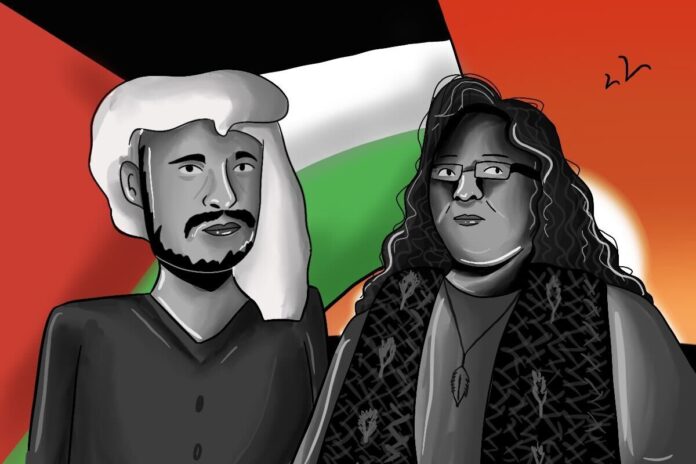
“Spaces of Exception” is a multimedia documentary that explores the hardships and resistance stories of Palestinians and Native Americans.
Filmmakers Matt Peterson and Malek Rasamny examine the juxtaposition between Native American reservations in the United States and Palestinian refugee camps in Lebanon. The documentary is part of The Native and The Refugee, a research project where the duo investigates that shared struggle.
It tells the story of two complex spaces through evocative cinematography and compelling interviews with Palestinian activists and members of The American Indian Movement. The film explores spaces that seem worlds apart but share similar experiences, stories and histories.
The Charlatan spoke with Peterson before his presentation at Carleton University on Sept. 26 to discuss the stories of people who go unnoticed.
The Charlatan (TC): Where did the title “Spaces of Exception” come from?
Matt Peterson (MP): It’s a way to think through these communities that exist within and around the Middle East and the U.S., but somehow live different lives than the majority within their countries. That was Palestinian refugee camps and American Indian reservations.
They’re governed differently and have different spatial phenomenon, and political, social and historical contexts. As American and Lebanese citizens, we felt like these spaces were sort of “off limits” to us. We didn’t know how they worked, how to visit them, how to get there or what life was like there.
There’s this legal category when during some kind of natural disaster, the government will declare a state of emergency which means that normal law is disbanded. Typically, that’s a temporary moment in time, but we became interested in these places where that phenomenon exists for decades, if not centuries.
TC: What was your creative process like?
MP: We researched which places in particular we wanted to visit because there’s more than 300 federally recognized reservations in the U.S. and there’s Palestinian refugee camps throughout Syria, Jordan, Gaza, the West Bank and Lebanon.
Malek and I were overseeing the whole project but worked with over a dozen cinematographers and editors to help shape it and give it a different perspective. Before we went, we found groups that were self organized that could invite us in and become collaborators or guides. We worked with different Arab and Native American cinematographers and editors to give the film its look and aesthetic.
We shot it over the course of five years. In 2019, we started to tour and screen it throughout the Middle East and Europe, and only really after Oct. 7, 2023 did the film really take off and become this mass phenomenon.
TC: Why did you choose the people featured in the documentary to share their stories?
MP: The first segment in the film is probably the most memorable because it highlights the Pine Ridge American Indian reservation. Pine Ridge was part of a number of resistances and we wanted to showcase the people involved in those movements, as well as their children.
Akwesasne, a reservation that borders both the U.S. and Canada, was also fascinating to us. It was a hub of the Mohawk Warrior Society which was similar to the American Indian Movement, and we wanted to showcase people and elders from the Mohawk Warrior Society.
In the Palestinian case, we met a younger group of activists within the Lebanese camp who organized themselves to improve living conditions or daily life. We didn’t speak to anyone that didn’t directly live or work within the camps or reservations. Everyone you hear from is directly part of that experience or community. We wanted to document an inside perspective.
TC: In the film, you used quotes as transitions, such as, “The mere fact of my breathing in the heart of the camp is a war, a war of existence.” How did you choose them?
MP: Malek and I don’t speak in the film — there’s no narration and no historical text to contextualize or introduce you — so we try to immerse the audience into those places and that experience.
The woman who says that quote, Selma, speaks to the refugee experience being one that both Israel and host countries want to erase.
Staying within the reservations or refugee camps means a refusal to assimilate into American society or broader Middle-Eastern society, which would erase or deny that history and that struggle for national self-determination.
TC: Considering the increase of attention on the ongoing conflict in Gaza, what are you hoping viewers will take away from this film?
MP: Hopefully it gives people context to understand what’s going on in Gaza, but also the kind of migrant and refugee issues being debated throughout the U.S. and Canada today.
The experiences of Palestinian refugees and Native Americans elsewhere can help give some historical context about the ethnic cleansing and violent displacement that took place over decades or centuries that people have to withstand and survive.
Particularly in Gaza, we see all these photos in the news of destroyed cities or villages, but we don’t necessarily learn who those affected people are and what their lives are like.
We hope the film can give some approximation of the human side of this issue and give some historical context of how we got to this point.
In some ways, Gaza itself is one large reservation that’s now come under attack.
This interview has been edited for length and clarity.
Featured graphic by Alisha Velji/the Charlatan.





